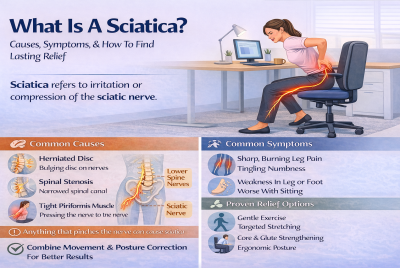Sciatic Nerve Surgery: What to Expect, Recovery, and Risks
Discover everything you need to know about sciatic nerve surgery, from costs and risks to recovery times. Dive in to get relief now! Find out if it’s the right solution for your sciatica pain. Get informed and make empowered choices today. Welcome to the world of sciatic nerve surgery, a topic that holds immense importance for individuals seeking relief from the debilitating effects of sciatica.
This article will explore sciatic nerve surgery’s purpose, procedures, benefits, and considerations. Sciatic nerve surgery is viable when non-surgical treatments have failed to alleviate sciatica symptoms. By targeting the root cause of the problem, this surgical intervention aims to relieve the compression or irritation of the sciatic nerve, restoring normal nerve function and providing long-lasting relief. Join us as we embark on a journey to understand the intricacies of sciatic nerve surgery, empowering you with knowledge and insights to make informed decisions about your health and well-being.
Can You Have Surgery On Sciatic Nerve?
Yes, surgery can be performed on the sciatic nerve to alleviate compression or irritation that is causing sciatica symptoms. Standard surgical procedures include microdiscectomy, lumbar laminectomy, and spinal fusion. However, surgery is typically considered a last resort when other non-surgical treatments fail to provide relief. Consulting with a qualified surgeon is essential to determine if surgery is the right option for an individual’s specific condition.
Understanding Sciatic Nerve Surgery
Surgery For Sciatica Nerve Pain
Surgery for the sciatic nerve is an option for individuals experiencing severe and chronic sciatica symptoms who have not responded to non-surgical interventions. The surgery aims to alleviate the compression or irritation of the sciatic nerve, providing long-term relief from pain, numbness, and tingling sensations. Standard surgical procedures include microdiscectomy, lumbar laminectomy, and spinal fusion, depending on the underlying cause and severity of the condition. While surgery can be highly effective, it is typically considered a last resort when other treatments have failed. Before deciding, it is essential to consult with a qualified surgeon to discuss the potential risks, benefits, and success rates specific to individual cases.
What Is The Sciatic Nerve?
The sciatic nerve is the longest and widest nerve in the human body, running from the lower back down through the hips, buttocks, and legs. When this nerve becomes compressed or irritated, it can lead to sciatica, characterized by pain, numbness, or tingling sensations along the nerve pathway.
How Do You Know When Sciatica Is Serious?
You know sciatica is serious when symptoms escalate beyond occasional discomfort. Warning signs include severe pain, progressive leg weakness, numbness affecting your ability to move, and loss of bladder or bowel control. These symptoms may indicate powerful nerve compression or other severe conditions. Immediate medical evaluation is essential for proper diagnosis and treatment, especially if these severe symptoms appear.
When Is Sciatic Nerve Surgery Recommended
Sciatic nerve surgery is typically considered when other non-surgical treatments have failed to provide adequate relief. It aims to alleviate the pressure on the sciatic nerve, providing lasting relief from the debilitating symptoms of sciatica.
Can Sciatic Nerve Be Fixed With Surgery?
Surgery can often effectively address the underlying issues causing sciatic nerve pain. A common procedure like microdiscectomy removes the herniated disc fragment pressing on the sciatic nerve, providing immediate relief for many patients. While surgery generally has a high success rate, it’s not a guaranteed permanent fix. Some people may experience recurrent symptoms or require additional treatments. Always consult your healthcare provider to assess whether surgery is the most appropriate solution for your condition.
Types Of Sciatic Nerve Surgery
There are several surgical procedures available for treating sciatica. Let’s take a closer look at some of the most common ones:
Microdiscectomy
Microdiscectomy is a minimally invasive procedure that involves removing a small portion of a herniated disc that is pressing against the sciatic nerve. This surgery aims to relieve the compression and allow the nerve to heal.
Lumbar laminectomy
A lumbar laminectomy, also known as decompression surgery, involves removing a portion of the lamina (the bony arch of the vertebra) to relieve pressure on the sciatic nerve. This procedure creates more space for the nerve to function properly.
Spinal Fusion
Spinal fusion may be recommended in some cases where there is significant instability in the spine. This surgery involves fusing two or more vertebrae together, reducing motion in the affected area, and alleviating pressure on the sciatic nerve.
Preparing For Sciatic Nerve Surgery
Before undergoing sciatic nerve surgery, adequate preparation is essential. Here are some important steps to follow:
Consultation With A Surgeon
Consult with a qualified spine surgeon to discuss your symptoms, medical history, and treatment options. They will perform a thorough examination and provide professional guidance.
Diagnostic Tests
To evaluate the condition of your sciatic nerve, your surgeon may order diagnostic tests such as MRI scans or X-rays. These imaging tests help identify the source of compression or injury.
Discussing The Risks And Benefits
Engage in a detailed discussion with your surgeon about sciatic nerve surgery’s potential risks and benefits. Understanding these aspects will help you make an informed decision about proceeding with the procedure.
Preoperative Instructions
Follow any preoperative instructions provided by your surgeon. These may include restrictions on eating or drinking before surgery, as well as discontinuing certain medications.
The Sciatic Nerve Surgery Procedure
Let’s dive into the details of what you can expect during sciatic nerve surgery:
Anesthesia
Before the surgery begins, you will be administered anesthesia to ensure you are comfortable and pain-free throughout the procedure. The type of anesthesia used will depend on the specific surgery and your surgeon’s recommendation.
Incision And Access
Once you are under anesthesia, your surgeon will make a small incision in the affected area to access the spine and sciatic nerve. The location and size of the incision may vary depending on the type of surgery being performed.
Nerve Decompression
The surgeon will carefully remove any structures or tissues that are compressing the sciatic nerve. This may involve removing a herniated disc, trimming bone spurs, or repairing damaged tissues.
Closure And Recovery
After the nerve decompression is complete, the incision will be closed using sutures or surgical staples. You will then be moved to a recovery area, where medical professionals will monitor your vital signs and provide postoperative care.
Recovery And Rehabilitation From Sciatic Nerve Surgery
Successful recovery from sciatic nerve surgery requires proper care and rehabilitation. Here’s what you need to know:
Postoperative Care
Following surgery, you will receive detailed instructions on postoperative care. This may include guidelines on wound care, medication management, and restrictions on physical activities.
Physical Therapy
Engaging in physical therapy is crucial for restoring strength, flexibility, and mobility after sciatic nerve surgery. Your physical therapist will design a personalized rehabilitation program to help you regain optimal function.
Managing Pain And Discomfort
It’s common to experience some pain and discomfort after surgery. Your surgeon may prescribe pain medications or recommend non-pharmacological approaches, such as heat therapy or gentle exercises, to manage pain effectively.
Surgery For Sciatica Nerve Recovery Time
Recovery time from sciatic nerve surgery varies from patient to patient. Generally, you can expect to leave the hospital within 24 hours after a microdiscectomy. Light activities like walking usually resume within a few days. However, heavy lifting and strenuous exercise often remain off-limits for about six weeks. Patients typically undergo physical therapy to strengthen back and leg muscles. Many experience significant pain relief almost immediately, but complete nerve healing can take several months. Always consult your healthcare team for a personalized recovery plan, as individual needs and complications may alter the typical timeline.
Potential Risks And Complications
Like any surgical procedure, sciatic nerve surgery carries some risks. It’s important to be aware of these potential complications:
Infection
Although rare, there is a small risk of developing an infection at the surgical site. Following postoperative care instructions and keeping the incision clean and dry can help minimize this risk.
Bleeding
Bleeding is a potential risk during and after surgery. Surgeons take precautions to minimize bleeding, but in some cases, additional interventions may be required to control it.
Nerve Damage
While sciatic nerve surgery aims to relieve nerve compression, there is a small risk of nerve damage during the procedure. Surgeons take utmost care to minimize this risk, but it’s important to be aware of the possibility.
Is Sciatica Surgery Dangerous?
While sciatic nerve surgery generally has a high success rate, it carries some risks like any surgical procedure. Possible complications include infection, bleeding, nerve damage, and anesthesia-related issues. Rarely, patients may experience continued pain or develop failed back surgery syndrome. Surgeons usually recommend surgery as a last resort after conservative treatments fail. Discuss the risks and benefits with your healthcare provider to make an informed decision tailored to your condition.
Sciatic Nerve Surgery Cost
Sciatic nerve surgery costs vary widely based on factors such as location, hospital, surgeon’s fees, and insurance coverage. In the United States, the average cost ranges from $15,000 to $50,000. This estimate includes surgeon fees, anesthesia, hospital stay, and post-operative care. Insurance often covers some expenses, but out-of-pocket costs can still be significant. Consult your healthcare provider and insurance company for a more accurate and personalized cost estimate.
Benefits And Success Rates Of Sciatic Nerve Surgery
Sciatic nerve surgery has shown promising results in providing long-term relief for individuals suffering from sciatica. The success rates vary depending on factors such as the underlying cause of sciatica, the surgical procedure performed, and individual factors. Consulting with a qualified surgeon can help you understand the potential benefits and success rates specific to your condition.
Sciatica Surgery Success Rate
The success rate for sciatica surgery, particularly microdiscectomy, is generally high. Studies indicate that 80-90% of patients experience significant pain relief following the procedure. However, success varies based on the specific cause of the sciatica, the surgeon’s expertise, and the patient’s overall health. Although most patients report immediate improvement, some may require additional treatments or even subsequent surgeries. Consult your healthcare provider to discuss your case and better understand the likelihood of a successful outcome.
Alternatives Treatment To Sciatic Nerve Surgery
There are several non-surgical alternatives to consider for treating sciatica. These options aim to alleviate pain and promote healing without the need for invasive procedures. Physical therapy is often recommended as it focuses on strengthening the muscles supporting the spine, improving flexibility, and relieving pressure on the sciatic nerve. Medications such as nonsteroidal anti-inflammatory drugs (NSAIDs), muscle relaxants, and neuropathic pain medications can help manage pain and inflammation. Additionally, epidural steroid injections can provide temporary relief by reducing inflammation around the sciatic nerve. Alternative therapies like chiropractic care, TENS Unit, acupuncture, and massage therapy may also be explored. It’s important to consult with a healthcare professional to determine the most suitable non-surgical treatment options based on individual needs and preferences.
In some cases, surgery may not be the first line of treatment for sciatica. Consider exploring alternative options, such as:
Physical Therapy
Physical therapy can help alleviate sciatic nerve pain by strengthening supporting muscles and improving posture. Your physical therapist can guide you through exercises and stretches that can provide relief.
Medications
Medications like nonsteroidal anti-inflammatory drugs (NSAIDs), muscle relaxants, or neuropathic pain medications may be prescribed to manage sciatica symptoms. Consult with your healthcare provider to determine the best medication options for you.
Epidural Steroid Injections
For temporary relief from severe sciatica symptoms, epidural steroid injections can be administered. These injections help reduce inflammation and provide pain relief, allowing you to participate in physical therapy and other non-surgical treatments.
How I Cured My Sciatica Pain
What Is The Fastest Way To Heal Sciatica?
The fastest way to heal sciatica combines multiple approaches. Pain relievers like NSAIDs can provide immediate relief. Physical therapy exercises help strengthen back and leg muscles, aiding long-term recovery. Corticosteroid injections offer temporary relief by reducing inflammation around the nerve. Some people find heat or ice packs effective for symptom management. However, surgery like microdiscectomy may offer the quickest resolution for severe cases unresponsive to conservative treatments. Always consult your healthcare provider for a tailored treatment plan, as the fastest route to healing varies depending on the underlying cause and individual health conditions.
Can Sciatica Last A Lifetime?
Sciatica usually only lasts for a while. Most people experience significant relief through conservative treatments or surgery. However, some individuals may have recurring episodes or chronic symptoms. Factors like underlying spinal conditions, lifestyle choices, and lack of physical activity can contribute to persistent issues. Early intervention and ongoing management, including physical therapy and lifestyle modifications, often improve outcomes. Consult your healthcare provider for a comprehensive treatment plan tailored to your condition.
When To Seek Medical Help
If you are experiencing persistent or worsening sciatica symptoms, it is essential to seek medical help. You should consider consulting a healthcare professional if you are encountering severe pain that affects your daily activities, causes difficulty in walking or standing, or if you are experiencing bladder or bowel dysfunction. Other concerning signs include sudden weakness or numbness in your legs or difficulty controlling your legs. Additionally, if your symptoms are not improving after a few weeks of self-care measures or if you have a history of trauma or cancer, it is advisable to seek medical attention. A healthcare provider can evaluate your condition, diagnose the underlying cause, and recommend appropriate treatment options to relieve your sciatica symptoms and prevent any potential complications.
Frequently Asked Questions (FAQs)
Is sciatic nerve surgery the only treatment option for sciatica?
No, It is typically considered when other non-surgical treatments have failed to provide adequate relief. Exploring alternative options and consulting with a qualified healthcare professional is important.
Is sciatica surgery a major surgery?
Sciatica surgery, such as microdiscectomy, is generally considered a minimally invasive rather than a major surgery. It usually involves a small incision and a shorter hospital stay, often with quicker recovery times.
Will I experience immediate relief after sciatic nerve surgery?
While some individuals may experience immediate relief, others may require time for the nerve to heal and inflammation to subside. Your surgeon will provide guidance on what to expect during the recovery process.
Are there any restrictions on physical activities after sciatic nerve surgery?
Your surgeon will provide specific guidelines on physical activities to avoid or modify during recovery. It’s crucial to follow these instructions to promote optimal healing.
What is the longest time sciatica can last?
Sciatica duration varies, but chronic cases can last several months or even years. Most people experience relief much sooner through treatment. Persistent symptoms require medical evaluation and potentially more aggressive intervention.
Extra FAQs Related To Sciatic Nerve Surgery
What are the long-term benefits of sciatic nerve surgery?
The surgery aims to provide long-term relief from sciatica symptoms, allowing individuals to resume their daily activities without pain and discomfort. It can significantly improve the quality of life for chronic sciatica patients.
How long does it take to recover from sciatic nerve surgery?
Recovery from sciatic nerve surgery varies. Patients typically leave the hospital within 24 hours and resume light activities in a few days. Complete nerve healing may take several months. Physical therapy often aids recovery.
Are there any non-surgical alternatives to consider for treating sciatica?
Non-surgical alternatives such as physical therapy, medications, and epidural steroid injections can be explored. These options aim to manage symptoms and provide relief without undergoing surgery.
Sciatic Nerve Surgery – Conclusion
In conclusion, sciatic nerve surgery can be a life-changing solution for individuals suffering from chronic sciatica pain. By addressing the underlying cause of nerve compression, these surgical procedures offer hope for lasting relief and improved quality of life. It is essential to carefully consider the risks and benefits, explore non-surgical alternatives, and consult with a qualified surgeon before making a decision. Proper preparation, postoperative care, and rehabilitation are crucial for a successful recovery. While surgery may not be the first line of treatment for those who have exhausted other options, this surgery can provide a path towards long-term relief and a future free from the limitations imposed by sciatica.
Disclaimer
Please note that the information provided in this article is for informational purposes only and should not replace professional medical advice. If you’re experiencing sciatica pain or any health concerns, it’s advisable to consult a healthcare professional for proper diagnosis and treatment.
👉 Explore more:




